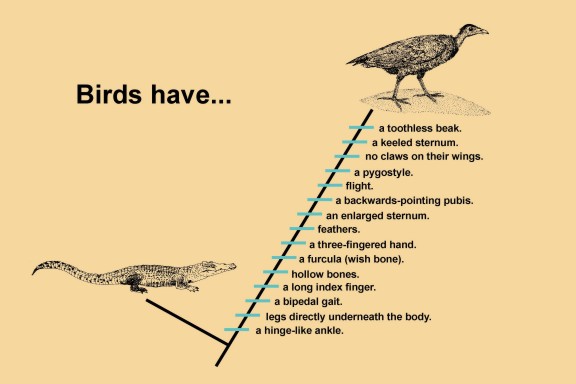

Eumaniraptora ("true maniraptorans), characterized by numerous features:
Nearly all eumaniraptorans are smaller than a human: many much smaller! Eumaniraptora comprises two main groups, Deinonychosauria and Avialae.
Deinonychosauria ("Deinonychus lizards") have a greatly enlarged sickle-shaped claw on pedal digit II, which is retractable. This was almost certainly used as a killing weapon, like a cat's claws. However, may have had other functions as well. Some deinonychosaurs had an arctometatarsus, but others had short broad feet. Two main types of deinonychosaurs: Dromaeosauridae (classic "raptors") and Troodontidae:
Note: some studies place troodontids and dromaeosaurids together in Deinonychosauria; others put dromaeosaurids closer to birds; still others put troodontids closer to birds. Nevertheless, it is within the maniraptoran coelurosaurs that the birds arose.
The remaining dinosaurs belong to Avialae ("bird wings"), colloquially called "birds". However, Avialae encompasses more than the advanced clade of living birds (Aves), and many Mesozoic avialians are hard to distinguish from deinonychosaurs. (In fact, the dromaeosaurid Rahonavis was first thought to be a primitive avialian).
Also hard to recognize good shared derived characters for Avialae at present, because basal deinonychosaurs are very, very avialian-like. At present, the following traits seem to be characteristic of Avialae, but some are also found in one or more small deinonychosaur (or reversed in an early bird or two):
Archaeopteryx lithographica ("ancient wing of the lithographic limestone") is the commonly considered the oldest known and basalmost avialian. It was also the first discovered basal avialian. In 1859, Darwin published the Origin; some used birds as a counter-example against evolution, as there were apparently know transitional forms between birds and other vertebrates. In 1860, a feather (identical to modern birds' feathers) was found in the Solnhofen Lithographic Limestone of Bavaria, Germany: a Late Jurassic formation. The following year, the skeleton of this feather-bearer was found. Like modern birds, it had:

Many saw Archaeopteryx as transitional between "normal" reptiles and birds. This specimen was bought by the British Museum (Owen's place of work). A second, and much better, specimen was found in 1877: this one was bought by the Humbolt Museum in Berlin. This specimen showed that the skull DID have teeth! (During the 20th Century, five more Archaeopteryx skeletons have been found: all from the Solnhofen Limestone).
The last twenty years has seen an explosion of discoveries in Mesozoic bird fossils. Once, birds
seemed very, VERY different from all other animals. If we just compared them to their
closest living relatives (crocodilians), we'd see:

We've already seen how many of these traits are present in dinosaurs (or more inclusive clades) outside of Avialae:
However, Archaeopteryx might NOT be a "bird" (avialian). In fact, deinonychosaurs might be more closely related to Avialae than is Archaeopteryx.
The remaining avian traits listed above evolved within Avialae during the Mesozoic.
There are several very primitive bird groups in the Early Cretaceous. The primitive groups retained grasping hands. Confuciusornithidae shows a toothless beak, but this evolved independantly of modern birds since most bird species between Archaeopteryx and Aves had teeth. Confuciusornithids are the most primitive birds with a pygostyle (independantly evolved in some oviraptorosaurs and at least one therizinosauroid!).
Ornithothoraces ("bird torsos") is the clade of flying birds. (Earlier bird types probably were limited fliers at best). Ornithothoracines are a Cretaceous-to-modern clade, characterized by (among lots of traits we're not going to deal with!) the carpometacarpus and tarsometatarsus. One of the clades of ornithothoracines, Enantiornithes, was the most diverse group of Mesozoic birds. They ranged from little sparrow-sized birds (the first truly small birds) to eagle-sized, and included short snouted seed eaters, insect eaters, fish eaters, worm eaters, and maybe even a meat eater. They have been found all over the world, and right up to the end of the Cretaceous.
Modern birds and their closest Mesozoic relatives form Ornithurae ("bird tails"). Ornithurines lost their manual unguals (although even enantiornithines probably had only a very weak grip at most) and evolved the synsacrum. Hesperornithines were sea-going birds of the Cretaceous. They had denser bones than most birds, and were swimming fish-hunters. In fact, their wings had atrophied away: the fore arm was lost and their humerus was no more than a simple splint. NOTE: hesperornithines are the ONLY known marine dinosaurs of the Mesozoic!!
Carninatae ("keeled ones") include Mesozoic Ichthyornis (a flying fish-hunter) and Aves proper. They had a keeled sternum which greatly increased the volume of their flying muscles. Aves itself is characterized by:
There is some evidence for true members of Aves (including a latest Cretaceous duck!) by the end of the Mesozoic. Aves are the only dinosaurs to survive the extinction at the end of the Cretaceous, and continued to evolve and specialize throughout the Cenozoic. However, that history is beyond the scope of this course!
So much for the phylogeny of birds (and dinosaurs in general). However, what about the origins of bird flight? That is next lecture's topic.
To Next Lecture.
To Previous Lecture.
To Syllabus.